It looks like you're using an Ad Blocker.
Please white-list or disable AboveTopSecret.com in your ad-blocking tool.
Thank you.
Some features of ATS will be disabled while you continue to use an ad-blocker.
share:
reply to post by diggindirt
True, we dont know the purpose to these giant heads and the reasoning behind their placement. Could their purpose be to ward off evil spirits much like the gargoyles placed around a church? Were they placed at entrance points into a village as a warning/deterrent to visitors.
True, we dont know the purpose to these giant heads and the reasoning behind their placement. Could their purpose be to ward off evil spirits much like the gargoyles placed around a church? Were they placed at entrance points into a village as a warning/deterrent to visitors.
reply to post by Spider879
A "western black", oh you mean a mixed race person, obviously depending on the mixing that could be so, yet the geneticist was clearly able to tell them "you have black in you".
A "western black", oh you mean a mixed race person, obviously depending on the mixing that could be so, yet the geneticist was clearly able to tell them "you have black in you".
LUXUS
reply to post by Spider879
A "western black", oh you mean a mixed race person, obviously depending on the mixing that could be so, yet the geneticist was clearly able to tell them "you have black in you".
Aaah not exactly they were able to tell where an ancestor came and that goes for the blond blue eyed camera woman filming the program she also had significant African Dna unbeknownst to her.

I wish I still had Alexander Von Wuthenau book Unexpected faces in America for apart from the large stone heads he have hundreds of smaller pieces that showed a wide variety of facial type and hair type below are some I found on the net.
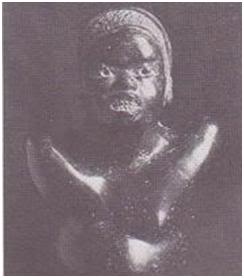
Girl of Las Bocas (Olmec c. 1000 BC)
National Museum of Mexico City
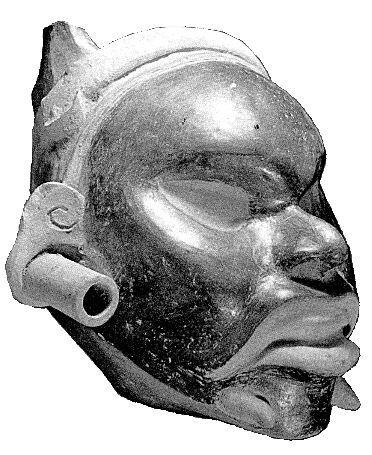
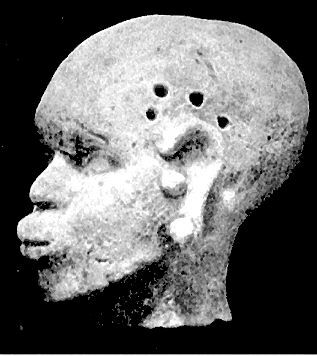
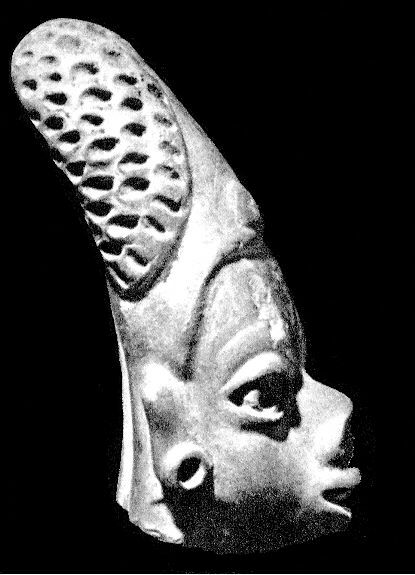
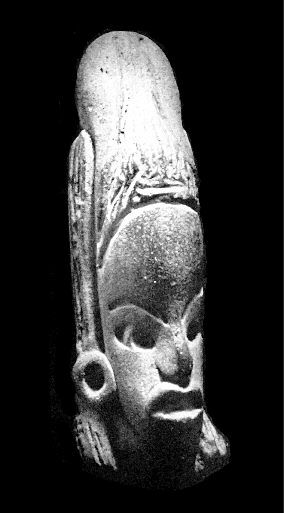
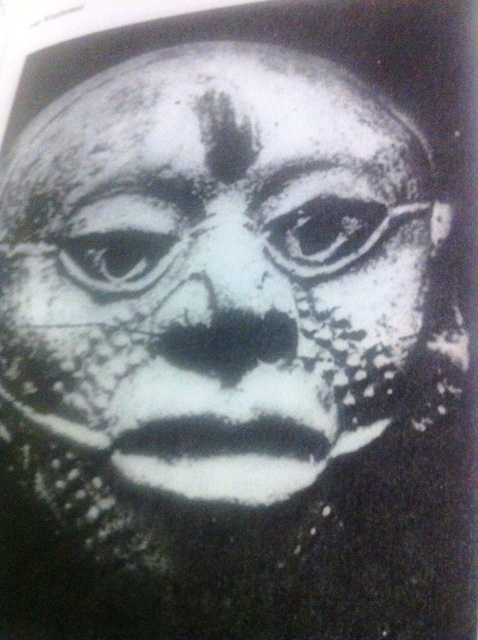
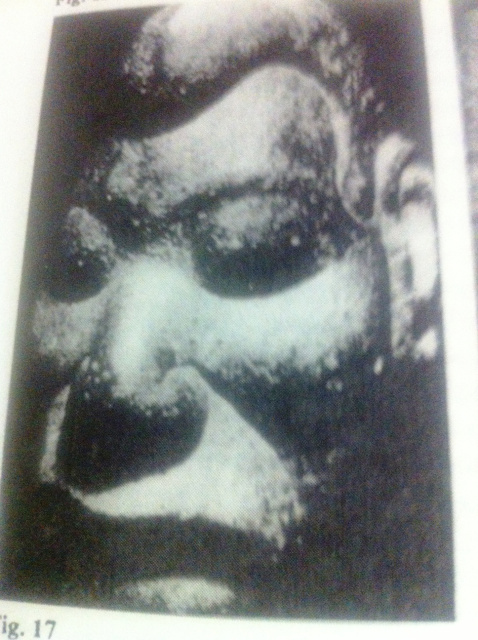
Again notice the hair line.
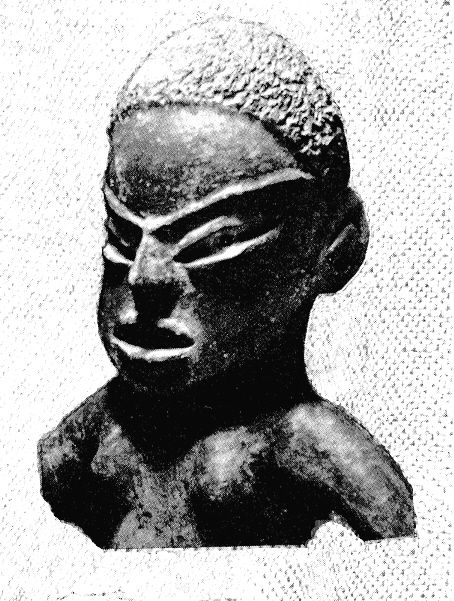

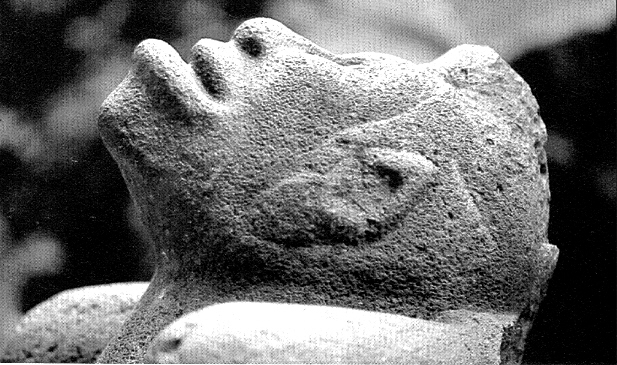
Olmec basalt sculpture of a man gazing at the sky
with both hands clasped behind his neck,
from la Venta, Tabasco, dated 600 BC or earlier
(Stierlin 1981).
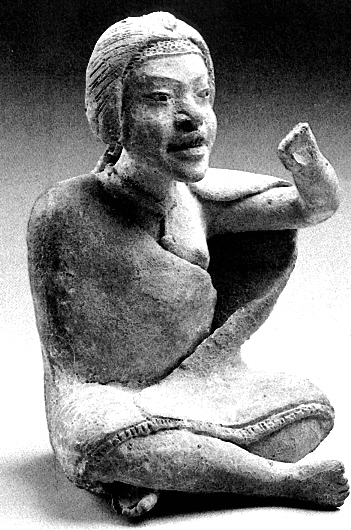
Note the woman wearing
a hair ps but wooly like hair
protrude out front.
www.faculty.ucr.edu...
Mostly from Von Wuthenau
www.moorishciviletter.net...
This site ^also have Von Wuthenau collections the Olmec figure I showed with the hair line is shown at different angles ruling out a head gear,sorry but there is no Url to capture the images for use on ATS you will have to copy in your personal files and give it a url. non the less it's easy to find the pic 3rd from the top left klik and enlarge.
edit on 20-1-2014 by Spider879 because: (no reason given)
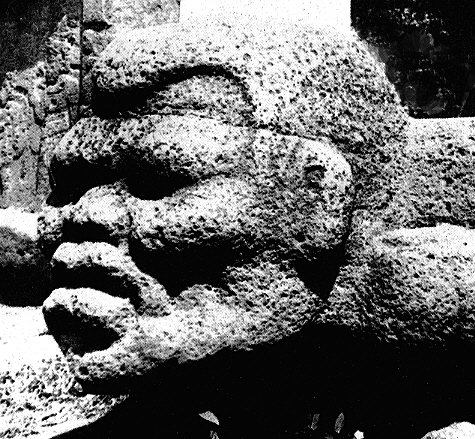
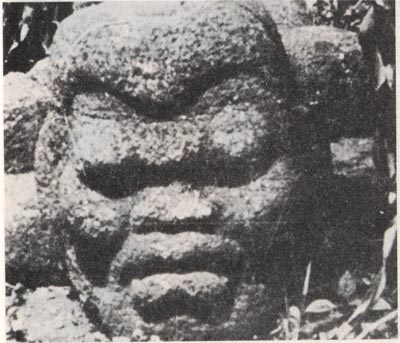
culptured stone head & upper body from the La Venta culture of
Tres Zapotes, Mexico, dated prior to 900 BC (Westheim 1950).
Ok found it front and side profile of the Olmec dude with
the hair line showing it's not a head gear.
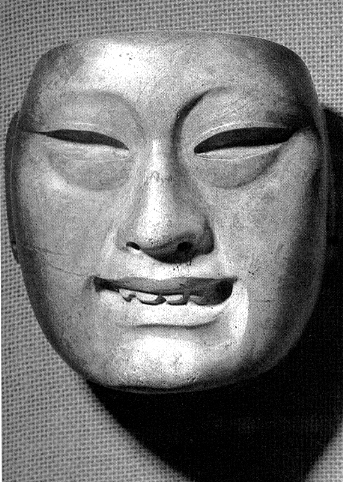

Hay I think I know this^ guy...
Yes there two very different faces belonging
to the same
culture complex.
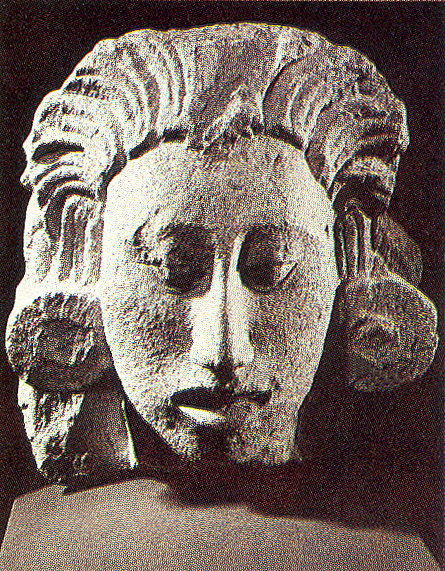
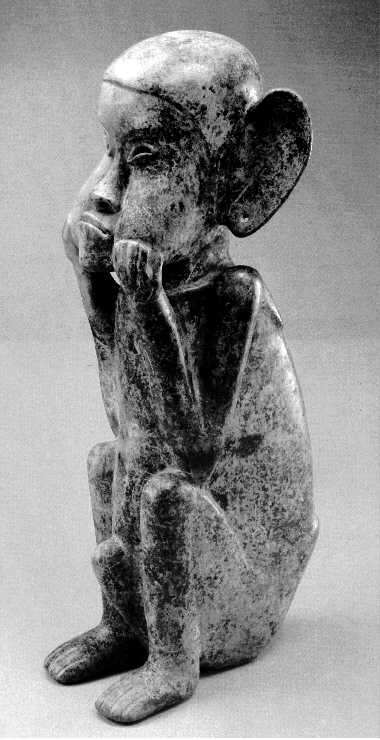
Ceramic sculpture with large ears, 2 ft. high, from Colima, Mexico,
dated 200 BC - 300 AD (Berjonneau et al. 1985).
Mickey Mouse was present.
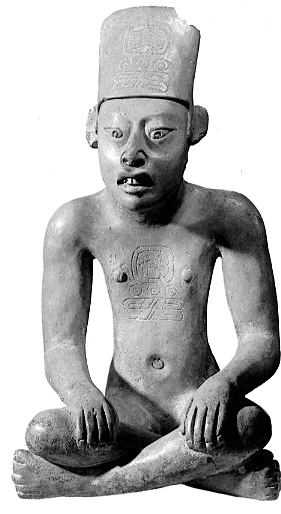

Fig. 77. Ceramic figures of a dog and baby, 10 1/2 and 11 in. high,
from Colima, Col., Mexico, dated 400 BC to 150 AD.
Yup they got jokes..
edit on 21-1-2014 by Spider879 because: (no reason given)
Hi Slayer,
Meant to post this a long time age in your other thread on the Olmec, as you had posted a number of images of Olmec/Chinese art that show a strong parallel. So here goes...
Did Ancient China Influence Olmec Mexico?
by David Kaufman (academia.edu)
This paper relates the Olmec art to art in China's Shang Dynasty.
In particular, the comparisons in Shamanism in both regions, the motifs used in 'monster' masks and language, the jade disks/earspools, among others.
The above paper appears to have been based on some of the research of Dr. Xu, "TRANSPACIFIC CONTACTS", (Dr. Mike Xu), TCU; Artifacts Comparison
This paper also focuses on Olmec motifs and Shang writing, which share a high degree of similarities.
I'll copy some of the images from both sources here:
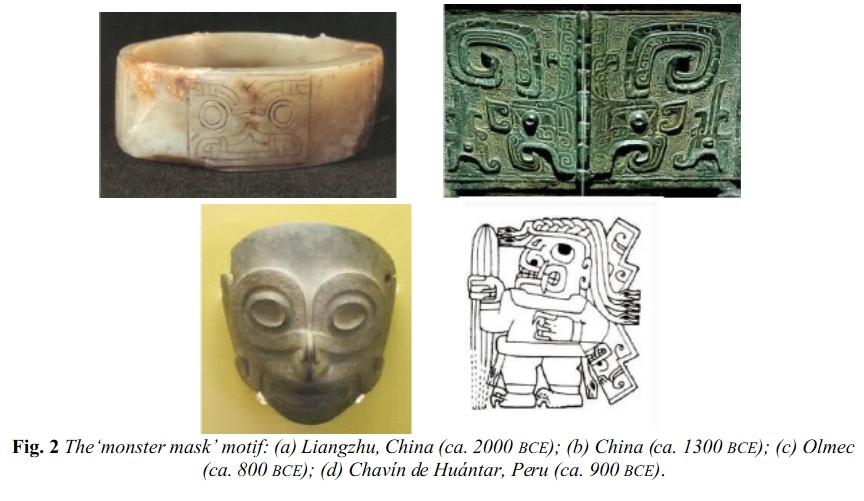
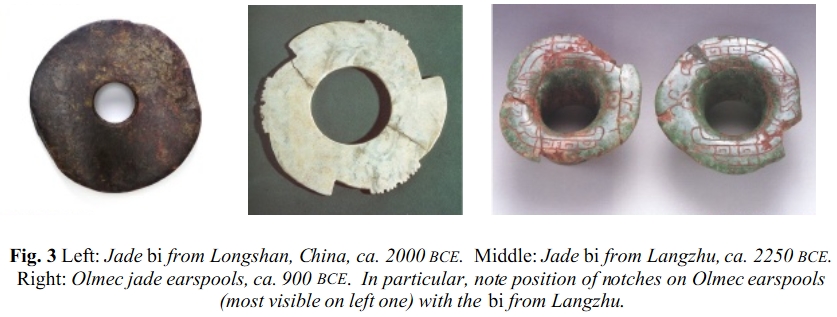


Similarities in Olmec motifs and Shang writing; (more at the source):
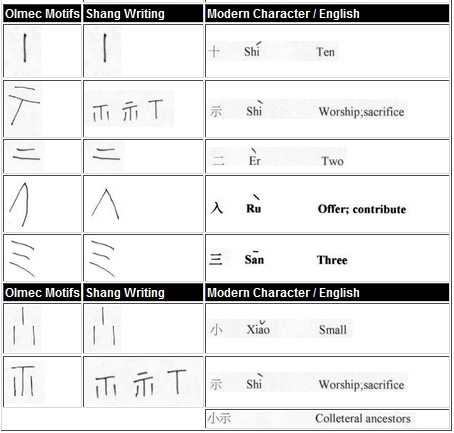
These two papers make it clear there was some sort of interaction between Shang China and the Olmec - but I won't go so far as to say "Ancient China influenced the Olmec", or vis-a-vis "The Olmec influenced ancient China", nor would I go so far as to say "Ancient China settled ancient Mexico".
What I do think is we have a go-between the two cultures, one that may have contributed to the peopling of both - the Austonesian people - remnants of which became the Liangzhu culture, as well as many cultures around the Pacific, ranging from the Philippines to what we would call Polynesia. It may have been the Shang themselves, or it may have been a 'Transpacific' culture with ties to both.
In your previous thread, I brought up the Shu people of China, who contributed both genetically and culturally to the Liangzhu culture of China (A neolithic society, circa 3000-2000 BC) that would eventually become the Shang, contemporaries of the Olmec. The Shu, like much of the Pacific, originated with the Austronesians. They were a relative late-exiting people leaving Africa, much of the globe had already been settled by modern sapien sapien popualtions. China, by Homo Erectus and succesive waves of modern man (however it may have blended together). Austronesians managed to populate the Pacific, from Madagascar to the Philippines to Hawaii (Polynesians are descendents of Austronesians), they also settled as the Shu in the mouth of the Yangtzee river in south central China, and blended with populations there.
I think it's important to keep in mind how the Austronesians managed to populate the remotest parts of Pacific long before we think of modern man having the ability to build long-distance open-ocean craft, just as the proto-Austroloid race managed to settle Australia 60,000 years ago, and who, be the way, had apparently also reached America, LONG before Paleoindians crossed Beringia - see: Australoid race - The first Americans?
Let me back up for a second, however, and say that the Olmec were probably much more related to the Austronesians than to 'proto-Austroloids', although the two groups do share a lot of similarities. At the very least, Olmec appear to be related to Pacific populations more-so that to other Paleoindians. Specifically, the Olmec show distinct traits similar to those found in the Liangzhu culture, as do the Shang in China.
There's a good map floating around out there that show the southern tip of South America having the oldest genetic populations. They count among their descendents the Fuegians and Patagonians, I believe the corrent term for them is "Paleoamerinds", while much later populations crossing out of Siberia via Berignia are "Amerinds", "Na-Dene Amerinds", and eventually "Aleuts" and "Innuits". The earlier group appeared to share genetics with Pacific-crossing Austronesians, which we HAVE to assume was possible given early settling of Hawaii, Australia, Madascar, and much of the Pacific island chains therein.
In that other thread I got my head handed to me for alluding Shu people as "African", but I had intended to say they most likely had an African appearance as much as any earlier Austroloid race had, and introduced some "African" features into native Chinese populations, and it could well be those features which give the Olmec (even after many thousands of years) an appearance which can lead some to think "African". Yet we can also safely assume they had "Chinese" features as well.
Liangzhu Culture
Austronesian Peoples
Map of migration into the Americas;
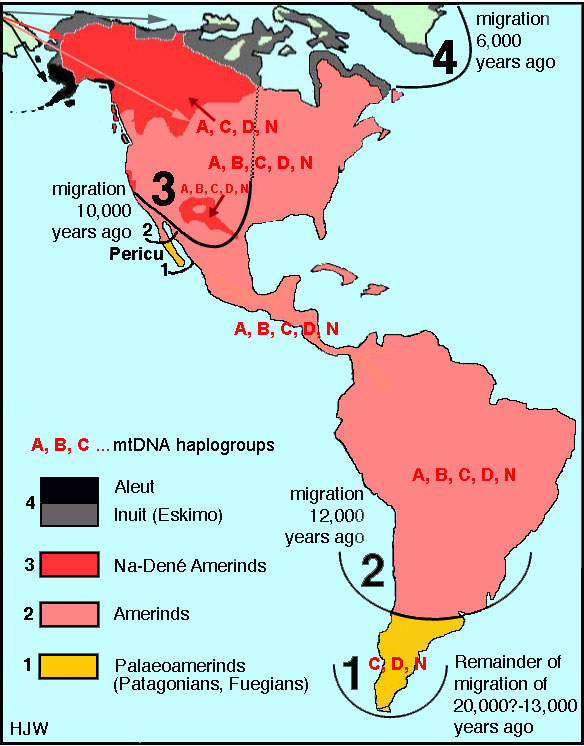
The yellow groups are those described as "populations with SouthEast Asian or Australian affiliations" - as well as being the OLDEST genetic populations in the Americas. An important distinction as it implies an ocean crossing population contributed to the gene pool not necessarily from those arriving via Beringia. Clearly this ocean crossing group had it's ties into China as well, and the Olmec interacted with the Shang.
Meant to post this a long time age in your other thread on the Olmec, as you had posted a number of images of Olmec/Chinese art that show a strong parallel. So here goes...
Did Ancient China Influence Olmec Mexico?
by David Kaufman (academia.edu)
This paper relates the Olmec art to art in China's Shang Dynasty.
In particular, the comparisons in Shamanism in both regions, the motifs used in 'monster' masks and language, the jade disks/earspools, among others.
The above paper appears to have been based on some of the research of Dr. Xu, "TRANSPACIFIC CONTACTS", (Dr. Mike Xu), TCU; Artifacts Comparison
This paper also focuses on Olmec motifs and Shang writing, which share a high degree of similarities.
I'll copy some of the images from both sources here:




Similarities in Olmec motifs and Shang writing; (more at the source):

These two papers make it clear there was some sort of interaction between Shang China and the Olmec - but I won't go so far as to say "Ancient China influenced the Olmec", or vis-a-vis "The Olmec influenced ancient China", nor would I go so far as to say "Ancient China settled ancient Mexico".
What I do think is we have a go-between the two cultures, one that may have contributed to the peopling of both - the Austonesian people - remnants of which became the Liangzhu culture, as well as many cultures around the Pacific, ranging from the Philippines to what we would call Polynesia. It may have been the Shang themselves, or it may have been a 'Transpacific' culture with ties to both.
In your previous thread, I brought up the Shu people of China, who contributed both genetically and culturally to the Liangzhu culture of China (A neolithic society, circa 3000-2000 BC) that would eventually become the Shang, contemporaries of the Olmec. The Shu, like much of the Pacific, originated with the Austronesians. They were a relative late-exiting people leaving Africa, much of the globe had already been settled by modern sapien sapien popualtions. China, by Homo Erectus and succesive waves of modern man (however it may have blended together). Austronesians managed to populate the Pacific, from Madagascar to the Philippines to Hawaii (Polynesians are descendents of Austronesians), they also settled as the Shu in the mouth of the Yangtzee river in south central China, and blended with populations there.
I think it's important to keep in mind how the Austronesians managed to populate the remotest parts of Pacific long before we think of modern man having the ability to build long-distance open-ocean craft, just as the proto-Austroloid race managed to settle Australia 60,000 years ago, and who, be the way, had apparently also reached America, LONG before Paleoindians crossed Beringia - see: Australoid race - The first Americans?
Skulls of individuals with Australoid morphologies have been found in the Americas, leading to speculation that peoples with phenotypical similarities to modern Australoids may have been the earliest occupants of the continent.[13][14][15] These specimens have been termed by some Pre-Siberian American Aborigines. If this theory is correct, it would mean that some Proto-Australoids continued the Great Coastal Migration beyond Southeast Asia along the continental shelf north in East Asia and across the Bering land bridge, reaching the Americas about 52,000 BCE.
Let me back up for a second, however, and say that the Olmec were probably much more related to the Austronesians than to 'proto-Austroloids', although the two groups do share a lot of similarities. At the very least, Olmec appear to be related to Pacific populations more-so that to other Paleoindians. Specifically, the Olmec show distinct traits similar to those found in the Liangzhu culture, as do the Shang in China.
There's a good map floating around out there that show the southern tip of South America having the oldest genetic populations. They count among their descendents the Fuegians and Patagonians, I believe the corrent term for them is "Paleoamerinds", while much later populations crossing out of Siberia via Berignia are "Amerinds", "Na-Dene Amerinds", and eventually "Aleuts" and "Innuits". The earlier group appeared to share genetics with Pacific-crossing Austronesians, which we HAVE to assume was possible given early settling of Hawaii, Australia, Madascar, and much of the Pacific island chains therein.
In that other thread I got my head handed to me for alluding Shu people as "African", but I had intended to say they most likely had an African appearance as much as any earlier Austroloid race had, and introduced some "African" features into native Chinese populations, and it could well be those features which give the Olmec (even after many thousands of years) an appearance which can lead some to think "African". Yet we can also safely assume they had "Chinese" features as well.
Liangzhu Culture
Austronesian Peoples
Map of migration into the Americas;

The yellow groups are those described as "populations with SouthEast Asian or Australian affiliations" - as well as being the OLDEST genetic populations in the Americas. An important distinction as it implies an ocean crossing population contributed to the gene pool not necessarily from those arriving via Beringia. Clearly this ocean crossing group had it's ties into China as well, and the Olmec interacted with the Shang.
reply to post by Blackmarketeer
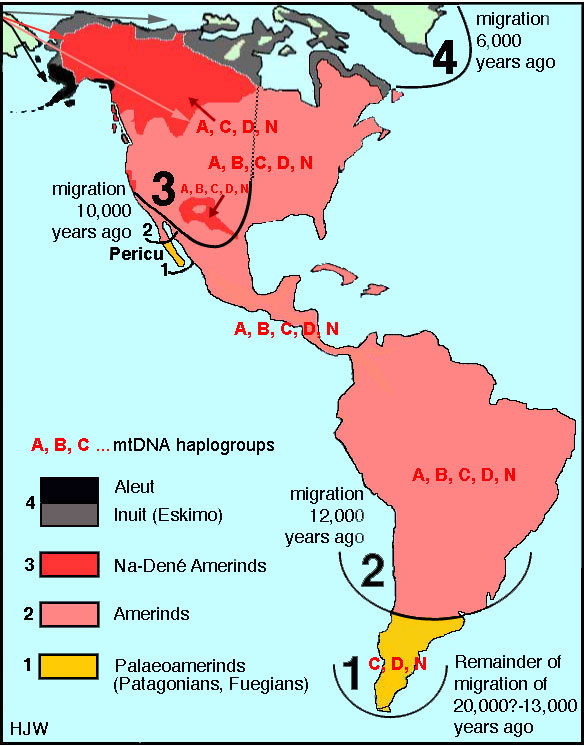
Interesting the yellow group on your map included California which is named after a fictional character a queen named Calafia who ruled over a nation of Blacks Amazon style.

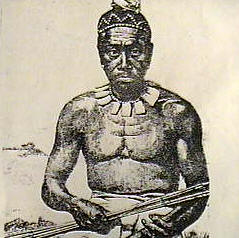
The first pic reminds some what of the Mayan trader God Ekchuah
It may well be a coincidence that these two post Colombian Black native Americans happened to be in the same area spoken of by the Spanish who earlier spoke of nations of them ,or could it be that they were residual survivors of that earlier epoch.

Mural on California Disney Land
Origin of the name California.
en.wikipedia.org...
Wiki sourced but good I have other sources in books that back this up.

Interesting the yellow group on your map included California which is named after a fictional character a queen named Calafia who ruled over a nation of Blacks Amazon style.


The first pic reminds some what of the Mayan trader God Ekchuah
It may well be a coincidence that these two post Colombian Black native Americans happened to be in the same area spoken of by the Spanish who earlier spoke of nations of them ,or could it be that they were residual survivors of that earlier epoch.

Mural on California Disney Land
Origin of the name California.
Sabed que a la diestra mano de las Indias existe una isla llamada California muy cerca de un costado del Paraíso Terrenal; y estaba poblada por mujeres negras, sin que existiera allí un hombre, pues vivían a la manera de las amazonas. Eran de bellos y robustos cuerpos, fogoso valor y gran fuerza. Su isla era la más fuerte de todo el mundo, con sus escarpados farallones y sus pétreas costas. Sus armas eran todas de oro y del mismo metal eran los arneses de las bestias salvajes que ellas acostumbraban domar para montarlas, porque en toda la isla no había otro metal que el oro.
Know that on the right hand from the Indies exists an island called California very close to a side of the Earthly Paradise; and it was populated by black women, without any man existing there, because they lived in the way of the Amazons. They had beautiful and robust bodies, and were brave and very strong. Their island was the strongest of the World, with its cliffs and rocky shores. Their weapons were golden and so were the harnesses of the wild beasts that they were accustomed to domesticate and ride, because there was no other metal in the island than gold.
–Las Sergas de Esplandián, (novela de caballería)
by García Ordóñez de Montalvo.
Published in Seville in 1510.
en.wikipedia.org...
Wiki sourced but good I have other sources in books that back this up.
edit on 22-1-2014 by Spider879 because: (no reason given)
reply to post by Spider879
Dark skinned however could easily be a trait associated with a number of Austronesian races, such as those in the Indian sub-continent, who are as dark skinned as any in Africa. It is extremely unlikely any African tribe left Africa around the time of the rise of the Olmec and settled into the Americas. There's no genetic evidence for that at all. The cultural traits of the Olmec seem to link them to the Liangzhu culture in China, which also links to the Shang Dynasty. It would also seem there was direct contact between the Shang and the Olmec.
To critique my post above, when I mention the Austronesians, it's with care not to imply a single homogenous group. Descendent cultures of Austronesians include Polynesian, Indonesians, Malanesians, Some Chinese, Taiwanese, Phillippino, and a host of Pacific cultures, and that list is by no means complete.
Among the most relevant of those Austronesian cultures to this discussion might be the Lapita, they are described as:
The Olmec do not appear to be a direct descendent of the Shang - they were not settled by the Shang, nor a colony of the Shang, nor genetically related to the Shang. They do however clearly share a cultural heritage similar to the Shang. The Shang derive some of the Shamanistic heritage through the Liangzhu culture/Shu peoples, which likely originated among the Austronesians populating that region in the late neolithic. The Lapita (also Austronesian) appear to have been expanding across the Pacific at that time and would eventually maintain a vast ocean trade network. For all we know the Lapita reached ancient Mexico and created a small merged population with native paleoindians, becoming the Olmec. Search Lapita and Olmec and you'll find a number of papers pointing out similarities between the two. The connection between Lapita and Shang would be through their Austronesian ancestry.
Carving giant heads are just one of those. A trait found throughout the Pacific.
Dark skinned however could easily be a trait associated with a number of Austronesian races, such as those in the Indian sub-continent, who are as dark skinned as any in Africa. It is extremely unlikely any African tribe left Africa around the time of the rise of the Olmec and settled into the Americas. There's no genetic evidence for that at all. The cultural traits of the Olmec seem to link them to the Liangzhu culture in China, which also links to the Shang Dynasty. It would also seem there was direct contact between the Shang and the Olmec.
To critique my post above, when I mention the Austronesians, it's with care not to imply a single homogenous group. Descendent cultures of Austronesians include Polynesian, Indonesians, Malanesians, Some Chinese, Taiwanese, Phillippino, and a host of Pacific cultures, and that list is by no means complete.
Among the most relevant of those Austronesian cultures to this discussion might be the Lapita, they are described as:
- Austronesians who migrated and populated many islands in the Pacific and Indian Ocean
- People who maintained large trade networks across seas but ceased once they had prosperous societies under kings and chiefs
The Olmec do not appear to be a direct descendent of the Shang - they were not settled by the Shang, nor a colony of the Shang, nor genetically related to the Shang. They do however clearly share a cultural heritage similar to the Shang. The Shang derive some of the Shamanistic heritage through the Liangzhu culture/Shu peoples, which likely originated among the Austronesians populating that region in the late neolithic. The Lapita (also Austronesian) appear to have been expanding across the Pacific at that time and would eventually maintain a vast ocean trade network. For all we know the Lapita reached ancient Mexico and created a small merged population with native paleoindians, becoming the Olmec. Search Lapita and Olmec and you'll find a number of papers pointing out similarities between the two. The connection between Lapita and Shang would be through their Austronesian ancestry.
Carving giant heads are just one of those. A trait found throughout the Pacific.
For a little more info on the Lapita;
Southern China is also where the Liangzhu culture would emerge...
To further illustrate a connection between the Lapita and the Shang Dynasty China, see:
Quests of the Dragon and Bird Clan
While on the subject of diffusionism, if you really want to tear your hair out, look at the topic of Shang script compared to Indus Valley Script, and the similarities to RapaNui script, Lapita art also to ancient Chinese script/art.
Ancient Mexico may have been settled by peoples as far back as 8000 BC as the archaeology record suggests, but it seems there's a lot of evidence of cultural diffusion arriving via the Pacific around 1500-1200 BC into that area. I would further speculate, thanks to the Austroloid skulls found and the genetic makeup of the oldest genetic populations (Feugians, Patagonians), as well as the character traits found among the Olmec busts, that some race of Austronesians made it to the Americas as well. If these were Lapitans, and they blended into the native Mesoamerinds, culminating in the Olmec, that they as a group would also be the most receptive to further contact by a transpacific group during the time of the Shang Dynasty - it may have even been the Shang themselves, in cooperation with the Lapita, as they all appear to have a vague shared cultural heritage.
An ultimate Southeast Asian origin of the Lapita complex is assumed by most scholars, perhaps originating from the Austronesians in Taiwan or southern China some 5,000 to 6,000 years ago.
Southern China is also where the Liangzhu culture would emerge...
This Neolithic dispersal was driven by a rapid population growth in east and southeast Asia (Formosa), and has often been called 'the express-train to Polynesia'. Burial pottery similar to "red slip" pottery of Taiwan, as well as detailed linguistic evidence,[6] seem to lend support to this theory.[4]
The orthodox view argued for by people like Roger Green and Peter Bellwood argues for a Triple-I model where Lapita arose from this Austronesian expansion through a process of intrusion into new territories, innovation of new technologies (such as the outrigger canoe), and integration with the existing populations.[7]
To further illustrate a connection between the Lapita and the Shang Dynasty China, see:
Quests of the Dragon and Bird Clan
Lapita, Taotie and other Face/Head Motifs
The possibility of a relationship between the Taotie face motif that dates back to the Shang Dynasty in China, and the previously discussed Kirtimukha images of India and the Kala images of Southeast Asia, has been explored in previous literature. Joseph Campbell in The Mythic Image (pp. 118-130) believes these motifs along with the Mesoamerican jaguar mask and the Greek Medusa all owe their similarities to diffusion.
While on the subject of diffusionism, if you really want to tear your hair out, look at the topic of Shang script compared to Indus Valley Script, and the similarities to RapaNui script, Lapita art also to ancient Chinese script/art.
Ancient Mexico may have been settled by peoples as far back as 8000 BC as the archaeology record suggests, but it seems there's a lot of evidence of cultural diffusion arriving via the Pacific around 1500-1200 BC into that area. I would further speculate, thanks to the Austroloid skulls found and the genetic makeup of the oldest genetic populations (Feugians, Patagonians), as well as the character traits found among the Olmec busts, that some race of Austronesians made it to the Americas as well. If these were Lapitans, and they blended into the native Mesoamerinds, culminating in the Olmec, that they as a group would also be the most receptive to further contact by a transpacific group during the time of the Shang Dynasty - it may have even been the Shang themselves, in cooperation with the Lapita, as they all appear to have a vague shared cultural heritage.
reply to post by Blackmarketeer
I agree multiple waves of migrations especially from the Asia/Pacific area ATS poster Pumkins Work also provided material on morphological development in the America's
www.abovetopsecret.com...
www.sil.si.edu...
Some time ago on another site I tried to trace the evolution of the Asian coins with the holes in the middle from places like Yap Island to Northeast Asia where it became modified and manageable,maybe I'll make a thread on it here,but in any case cross fertilization in Asian Pacific cultures is evident,and just by eye balling figurines, sculptures and statues it seems there was at least three different kinds of morphological facial traits that made up the Olmecs in a single American culture.

Yap Currency

Ancient Chinese Currency
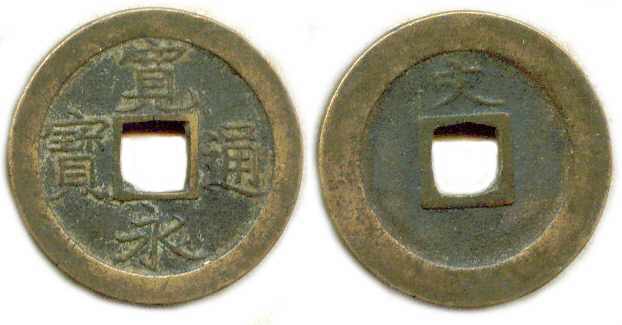
Japanese currency
I agree multiple waves of migrations especially from the Asia/Pacific area ATS poster Pumkins Work also provided material on morphological development in the America's
www.abovetopsecret.com...
www.sil.si.edu...
Some time ago on another site I tried to trace the evolution of the Asian coins with the holes in the middle from places like Yap Island to Northeast Asia where it became modified and manageable,maybe I'll make a thread on it here,but in any case cross fertilization in Asian Pacific cultures is evident,and just by eye balling figurines, sculptures and statues it seems there was at least three different kinds of morphological facial traits that made up the Olmecs in a single American culture.

Yap Currency

Ancient Chinese Currency

Japanese currency
edit on 22-1-2014 by Spider879 because: (no reason given)
new topics
-
Bobiverse
Fantasy & Science Fiction: 2 hours ago -
Florida man's trip overseas ends in shock over $143,000 T-Mobile phone bill
Social Issues and Civil Unrest: 2 hours ago -
Former Labour minister Frank Field dies aged 81
People: 4 hours ago -
SETI chief says US has no evidence for alien technology. 'And we never have'
Aliens and UFOs: 6 hours ago -
This is our Story
General Entertainment: 9 hours ago -
President BIDEN Vows to Make Americans Pay More Federal Taxes in 2025 - Political Suicide.
2024 Elections: 11 hours ago
top topics
-
President BIDEN Vows to Make Americans Pay More Federal Taxes in 2025 - Political Suicide.
2024 Elections: 11 hours ago, 14 flags -
Should Biden Replace Harris With AOC On the 2024 Democrat Ticket?
2024 Elections: 17 hours ago, 6 flags -
One Flame Throwing Robot Dog for Christmas Please!
Weaponry: 16 hours ago, 6 flags -
Florida man's trip overseas ends in shock over $143,000 T-Mobile phone bill
Social Issues and Civil Unrest: 2 hours ago, 5 flags -
Don't take advantage of people just because it seems easy it will backfire
Rant: 16 hours ago, 4 flags -
Ditching physical money
History: 15 hours ago, 4 flags -
SETI chief says US has no evidence for alien technology. 'And we never have'
Aliens and UFOs: 6 hours ago, 4 flags -
Former Labour minister Frank Field dies aged 81
People: 4 hours ago, 4 flags -
Ode to Artemis
General Chit Chat: 12 hours ago, 3 flags -
This is our Story
General Entertainment: 9 hours ago, 3 flags
active topics
-
Tucker Carlson UFOs are piloted by spiritual entities with bases under the ocean and the ground
Aliens and UFOs • 44 • : DISBOLD -
Found this website, interesting! "THE GLOBAL SOURCING ASSOCIATION"
New World Order • 8 • : DISBOLD -
"We're All Hamas" Heard at Columbia University Protests
Social Issues and Civil Unrest • 273 • : FlyersFan -
The Reality of the Laser
Military Projects • 38 • : 5thHead -
President BIDEN Vows to Make Americans Pay More Federal Taxes in 2025 - Political Suicide.
2024 Elections • 58 • : WeMustCare -
VirginOfGrand says hello
Introductions • 3 • : F2d5thCavv2 -
The Acronym Game .. Pt.3
General Chit Chat • 7743 • : F2d5thCavv2 -
SETI chief says US has no evidence for alien technology. 'And we never have'
Aliens and UFOs • 25 • : Cvastar -
Suspended Nigerian Poverty Minister had $24M in her Bank Accounts
Political Issues • 11 • : malamarabi -
Should Biden Replace Harris With AOC On the 2024 Democrat Ticket?
2024 Elections • 47 • : Cvastar
